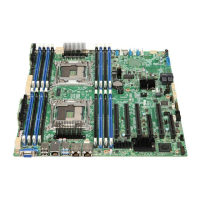Intel® Server Board S2600CW Platform Management Intel® Server Board S2600CW Family TPS
92 Revision 2.4
5.5.4 Security
The KVM redirection feature supports multiple encryption algorithms, including RC4 and AES.
The actual algorithm that is used is negotiated with the client based on the client’s capabilities.
5.5.5 Availability
The remote KVM session is available even when the server is powered-off (in stand-by mode).
No re-start of the remote KVM session shall be required during a server reset or power on/off.
A BMC reset (for example, due to a BMC Watchdog initiated reset or BMC reset after BMC FW
update) will require the session to be re-established.
KVM sessions persist across system reset, but not across an AC power loss.
5.5.6 Usage
As the server is powered up, the remote KVM session displays the complete BIOS boot
process. The user is able interact with BIOS setup, change and save settings as well as enter
and interact with option ROM configuration screens.
At least two concurrent remote KVM sessions are supported. It is possible for at least two
different users to connect to the same server and start remote KVM sessions.
5.5.7 Force-enter BIOS Setup
KVM redirection can present an option to force-enter BIOS Setup. This enables the system to
enter F2 setup while booting which is often missed by the time the remote console redirects
the video.
5.5.8 Media Redirection
The embedded web server provides a Java applet to enable remote media redirection. This
may be used in conjunction with the remote KVM feature, or as a standalone applet.
The media redirection feature is intended to allow system administrators or users to mount a
remote IDE or USB CD-ROM, floppy drive, or a USB flash disk as a remote device to the server.
Once mounted, the remote device appears just like a local device to the server, allowing
system administrators or users to install software (including operating systems), copy files,
update BIOS, and so on, or boot the server from this device.
The following capabilities are supported:
The operation of remotely mounted devices is independent of the local devices on the
server. Both remote and local devices are useable in parallel.
Either IDE (CD-ROM, floppy) or USB devices can be mounted as a remote device to the
server.
It is possible to boot all supported operating systems from the remotely mounted
device and to boot from disk IMAGE (*.IMG) and CD-ROM or DVD-ROM ISO files. See
the Tested/supported Operating System List for more information.

